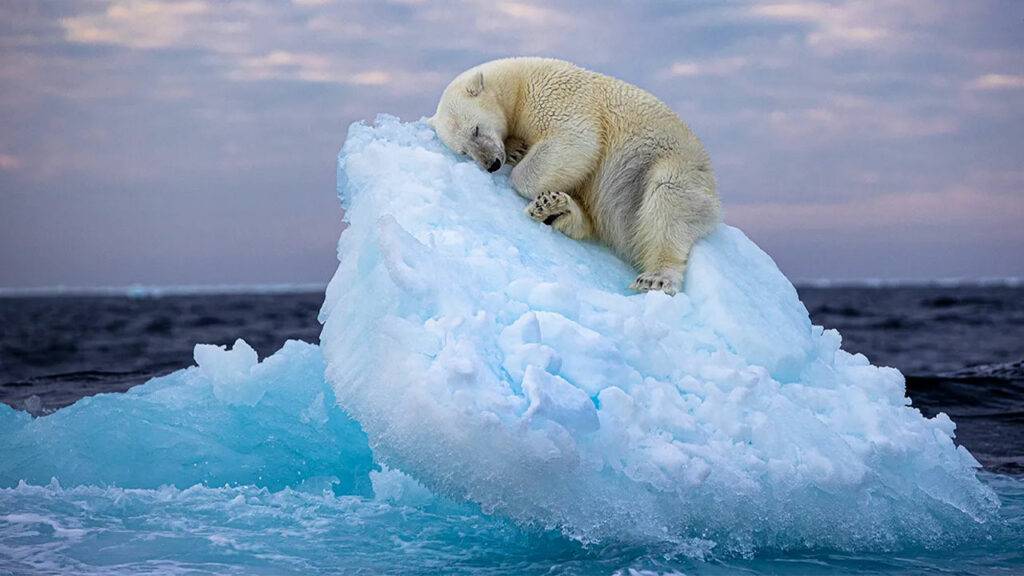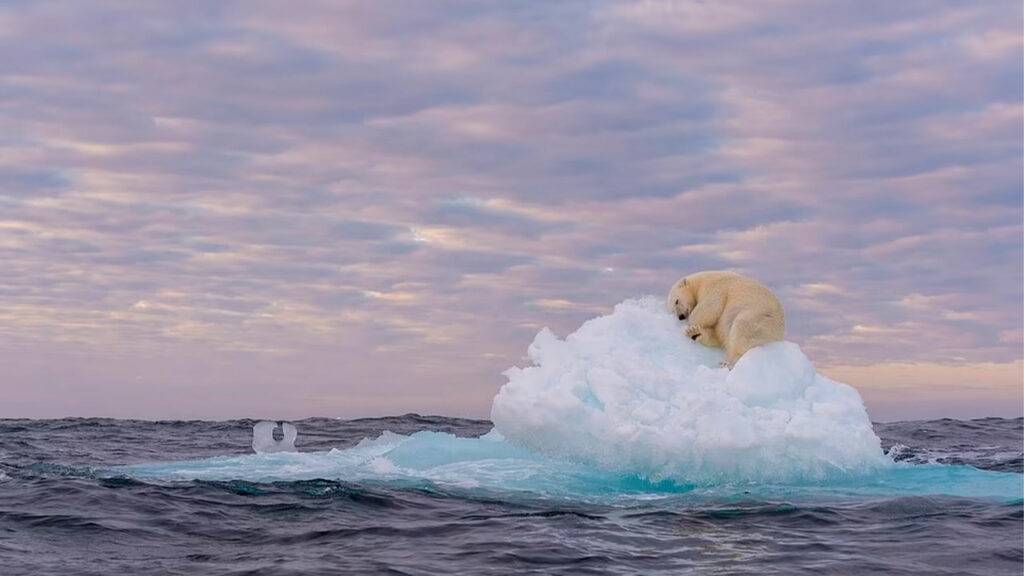Polar Bear Sleeping On Iceberg: Capturing the Fragile Serenity of a Melting Arctic World

Polar Bear Sleeping On Iceberg
One of the world’s most prestigious wildlife photography awards, the Natural History Museum of London’s Wildlife Photographer of the Year, has recently crowned its winner. Nima Sarikhani clinched the coveted award with her captivating image titled “Ice Bed,” featuring a polar bear peacefully sleeping on sea ice in Norway’s Svalbard archipelago.
This extraordinary photograph not only showcases the mesmerizing beauty of the Arctic but also sheds light on the pressing issues of climate change affecting polar bear habitats.
A Challenging Expedition
According to the museum’s description of the photo, Sarikhani’s journey to capture this moment was no easy feat. Spending three days searching for polar bears aboard an exploration vessel in the Svalbard archipelago, the photographer faced challenging conditions, including thick fog. However, perseverance paid off when the vessel encountered sea ice and spotted two polar bears.

Sleeping Polar Bear Photo
Tracking the polar bears for eight hours, the photographer and the crew witnessed an enchanting moment just before midnight. “Under the light of the midnight sun, the bear used its powerful arms to claw out a bed on a small iceberg before drifting off to sleep,” as described in the museum’s press release. This extraordinary scene, immortalized by Sarikhani’s lens, resonated with people worldwide.
Emotions Stirred by a Sleeping Polar Bear
Nima Sarikhani expressed her honor in winning the People’s Choice award among nearly 50,000 entries from 95 countries. The photograph, now named “Ice Bed,” will be displayed at the museum’s Wildlife Photographer of the Year exhibit until June 30. Sarikhani hopes the image stirs emotions and inspires hope amidst the global challenge of climate change.
“This photograph has stirred strong emotions in many of those who have seen it,” Sarikhani stated. “While climate change is the biggest challenge we face, I hope that this photograph also inspires hope. There is still time to fix the mess we have caused.”
A Director’s Perspective
Douglas Gurr, director of the Natural History Museum, expressed his admiration for the image, calling it a “breathtaking and poignant” reminder of the beauty and fragility of our planet. Gurr emphasized the integral bond between animals and their habitats, using the image as a visual representation of the detrimental impacts of climate warming and habitat loss.
Polar Bear Behavior and Habitat Concerns
Polar bears, renowned for their unique behaviors, are known to dig themselves spots to sleep, often referred to as “day beds.” According to scientist Thea Bechshoft at Polar Bears International, these majestic creatures take one- to two-hour-long naps, especially after a satisfying meal.

The area in which the photograph was taken is considered one of the most isolated in the world, with 19 polar bear populations relying on sea ice for travel and offshore hunting. However, a 2018 report by the Norwegian Centre for Climate Services highlighted concerning trends in Svalbard, including a 3 to 5 degrees Celsius increase in air temperatures over the past 40 to 50 years.
Climate Impact on Polar Bears
The report also noted heavy winter rainfall, leading to some areas being “ice-free most of the year.” Such conditions affect the bears’ ability to hunt and travel safely. Jon Aars, a researcher of polar bears in the region, explained, “While the bears that follow sea ice may still be able to hunt year-round, this is increasingly over deeper waters which may be less productive.”
Less sea ice also results in reduced genetic diversity among polar bears. Aars pointed out, “There aren’t as many opportunities for different groups to mix, leading to increased inbreeding among resident bears.” Although Svalbard’s polar bear population is currently considered stable, the ongoing rise in global temperatures poses a threat to their long-term survival.












